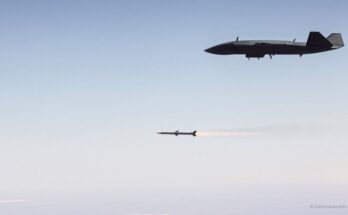by Matthew W. Beres, Forecast International.
In January, Air Force Lt. Gen. Bradley Heithold, head of Air Force Special Operations Command, mentioned the use of directed energy weapons, aka lasers, on U.S. Air Force aircraft. On July 28, at the Directed Energy Summit in Virginia, Heithold again expounded upon the use of directed energy weapons in the Air Force. The summit, hosted by Booz Allen Hamilton and the Center for Strategic and Budgetary Assessments (CSBA), explored new issues and solutions related to directed energy capabilities.
There was talk of lasers mounted on the AC-130 gunship and smaller fighters, most likely the F-15E Strike Eagle. The lasers will be used to shoot incoming anti-aircraft weapons and to attack airborne and ground targets, all the while preventing human casualties. Rather than the narrow defensive utilization proposed by the Navy and Marines, the Air Force also wants to utilize lasers for precise offensive action, available with customizable options along the spectrum of enemy destruction.
And we’re talking about a paradigm shift in destruction. The Meteor beyond-visual-range air-to-air missile (BVRAAM) can fly at over 1.36 kilometers per second, with a range of 100+ kilometers, at a cost of $2.15 million per missile. Even a cheap $100,000 missile is still “one and done.” A laser moves at the speed of light – 186,000 miles per second. One aircraft can have the capacity with 100 gallons of gas to fire hundreds of shots versus a half dozen, $100,000 each, one-and-done missiles. And let’s not downplay the human lives saved. One of the most powerful weapons is wartime nationalism or terrorist recruitment propaganda that thrives off the death of innocent civilians. If the Air Force can destroy a target with zero human casualties, the enemy has lost a major war effort resource.
The Air Force is focused on integrating lasers via a three-phase plan that will result in external additions to aircraft, not full airframe installations like guns or radar. The first part of the plan, to be completed around 2020, involves a laser with 10 kilowatts of power, called the Self-protected High-Energy Laser Demonstration (SHIELD). The second phase is a longer range 100-kilowatt defensive power laser. The third phase is a long-range 300-kilowatt offensive system capable of destroying enemy aircraft and ground targets.
Don’t confuse directed energy with Hollywood lasers that can blow up an enemy fighter jet. Real life directed energy weapons will have the capacity to burn out missile or aircraft electronics, especially those with multimode sensors. To visualize the impact, watch this video, which shows a 30-kilowatt laser fired from a C-130 turret literally burning a hole through the manifold of a small truck engine. Ramp this up to 150 kilowatts or 300 kilowatts, and you can imagine the results.
One of the biggest hurdles is how to fit an entire laser system onto a plane. A 1,100-kilogram Laser Weapon System (LaWS) or similar laser can be mounted on a ground base, a Navy ship, or even a truck with no significant effect on their respective operational capacity. But on a fully loaded 82-ton AC-130J or 40-ton F-15E, this could pose a problem. An overloaded aircraft may have important defense gaps that can leave the aircraft vulnerable to conventional weapons.
A project jointly funded by the Defense Advanced Research Projects Agency and the Air Force Research Laboratory began field tests this summer of the High-Energy Liquid Laser Area Defense System. The HELLADS laser is capable of 150-kilowatt bursts within a 3-cubic-meter system weighing in at less than 5 kilograms per kilowatt of power. Heithold said that in a couple of years, deployment of the weapon might start with the AC-130J, which can give up 2,300-4,500 kilograms for laser operations.
But size isn’t the only problem. Recently tested lasers can only reach up to 7 kilometers with a 21-kilowatt beam. This relatively short-range beam is vulnerable to atmospheric turbulence and thermal blooming (dissipation of the laser via heat absorption through air). This short-range, vulnerable beam with 35 percent fiber-optic electrical to optical efficiency requires 1 megawatt of power to create a 300-kilowatt laser capable of longer range utilization. And even with a high surface-to-volume ratio, the laser requires significant cooling, which means more weight. Even if these problems were mitigated, inexpensive anti-laser coatings in use by China can simply deflect the laser, much like you deflect light with a mirror. These are some of the problems that scrapped the 2012 Airborne Laser program, and why funding is at the lower end of projected defense budgets.
Anticipated funding for directed energy programs is around $300 million a year, with larger-scale demonstrations ramping up within the next five years. Although Rep. Doug Lamborn, co-chair of the Congressional Directed Energy Caucus, supports the advancements as a technical edge on U.S. enemies, he doesn’t see money going toward directed energy advancement if sequestration continues. His support for laser weapon technology focuses less on short-term expenditures and more on long-term taxpayer savings. He said that once lasers are in place they can be fired for mere dollars, destroying a low-value threat inexpensively instead of losing a $500,000 one-and-done missile.
If the weapons systems are bulky, have limited range, and are easily deflected by a paint job, is it worth the effort? Is it worth the relatively meager $300 million per year for research when the estimated U.S. debt is $19 trillion? It is only through continued development and deployment of directed energy weapons that warfighting capabilities and integration with other modern warfare systems will progress toward a more cost-effective solution that still manages to enhance warfighting capabilities. Certainly if integrated operationally with the newest related warfare sectors – cybersecurity, electronic warfare, and let’s not forget propaganda – the United States could develop a significant military edge on competitors that are rapidly playing catch-up in those areas.
For 50 years, Forecast International intelligence reports have been the aerospace and defense industry standard for accurate research, analysis, and projections. Our experienced analysts compile, evaluate, and present accurate data for decision makers. FI's market research reports offer concise analysis of individual programs and identify market opportunities. Each report includes a program overview, detailed statistics, recent developments and a competitive analysis, culminating in production forecasts spanning 10 or 15 years. Let our market intelligence reports be a key part of reducing uncertainties and mastering your specific market and its growth potential. Find out more at www.forecastinternational.com


